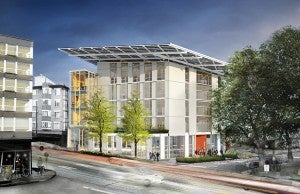On Earth Day this year, The Bullitt Center opened its doors in Seattle, Washington. The six-story building is being hailed as the greenest commercial building in the world. Its specs are very impressive indeed, including:
- 56,000-gallon cistern for rainwater collection;
- Solar photovoltaic (PV) panels on the roof that are estimated to generate 230,000 kilowatt-hours per year;
- Glass panels to showcase the engineering, including quick response codes to allow visitors to use their smartphones to find out more;
- Real-time measurements of the building’s indoor air quality, energy conservation, PV production and water levels;
- A mini-weather station that sends data to the building so that it can make adjustments to maximize tenant comfort and energy conservation; and
- Measurement of energy use down to the individual socket.
The Bullitt Center aims to be certified through the Living Building Challenge, a rigorous set of standards that requires the building to meet complete water and energy self-sufficiency. The Living Building Challenge has registered nearly 150 projects in 10 countries, but only three buildings have been certified in the US (in Missouri, New York and Hawaii). It has been endorsed by the US Green Building Council (USGBC), originator of the Leadership in Energy and Environmental Design (LEED) standard, and is not meant to be a competition, rather a challenge to architects and engineers to aim even higher in their sustainable design efforts.
The Bullitt Center is a project of the Bullitt Foundation, and its leaders state that if the building is still the highest-performing office building in ten years, then they have failed. They want to demonstrate that a building can be both self-sustaining and commercially viable and to serve as an example for others to learn and innovate beyond what they’ve done.
This, I think, is the message we need to take away. Dreaming big inspires others to achieve success beyond today’s standards. The goal of putting a man on the moon and then allowing the scientists and thinkers to figure out how to do it may be an old example, but it’s a salient one. Now we face a new goal: how to sustain our water resources, reduce harmful global warming pollution and accelerate the transition to a clean, low-carbon energy future for us and future generations. And EDF is thinking big.
Imagine a community with solar panels on every home, an electric car charging in the garage and smart appliances that are working to reduce energy use and lower electric bills without sacrificing comfort. This type of “living smart grid laboratory” is alive and well in Austin, Texas today through Pecan Street Inc. EDF helped create and is supporting and collaborating with Pecan Street to build an energy system that is cleaner, more reliable and less expensive than anything we’ve seen before. Through Pecan Street’s research, more than 500 homes in Austin – and soon hundreds more in other cities – are participating in the country’s most advanced and detailed research on consumer energy use.
We must set our own goals high in order to inspire others to not only meet expectations, but also to exceed conventional measures. Pecan Street is setting a high bar for neighborhoods across the US. And, much like what the architects of the Bullitt Center and the astronauts of Apollo 11 have taught us, these types of ground-breaking innovations require big ideas and a perseverance to succeed.










